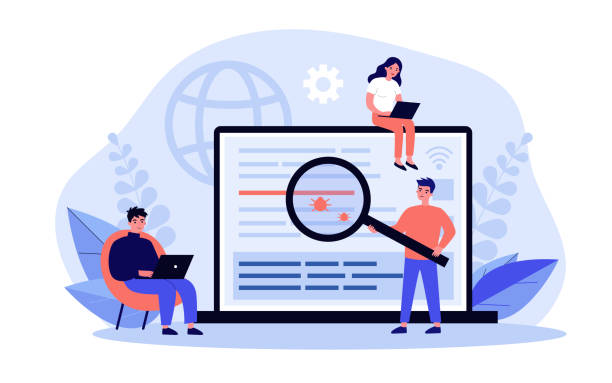1. Introduction and Importance of Multilingual Website Design in Today’s World

Today, in the era of globalization, access to international markets is vital for any business.
One of the most powerful tools to achieve this goal is #multilingual_website_design.
This approach allows you to present your website content in various languages, thereby connecting with a wider audience worldwide.
The importance of multilingual website design is not limited to attracting new customers; it also enhances brand credibility, improves user experience, and reduces bounce rates.
By providing information in users’ native languages, you not only offer them comfort and ease but also demonstrate respect for their cultural and linguistic needs.
This approach can make a significant difference in user interaction with your website and convert them into loyal customers.
For instance, a German user who can read product information in German is more likely to feel comfortable and trusting than an English-speaking user who has to rely on translation tools.
This is particularly evident in #specialized industries and #educational fields where accuracy in conveying concepts is crucial.
Investing in a multilingual website means investing in the future of your business on a global scale.
Are you falling behind large online stores in the competition?
Rasaweb, with its professional e-commerce website design, brings your business online and increases your market share!
✅ Increased brand credibility and customer trust
✅ Easy shopping experience leading to more sales
⚡ Act now to receive a free website design consultation!
2. Competitive Advantages and Growth Opportunities in Global Markets
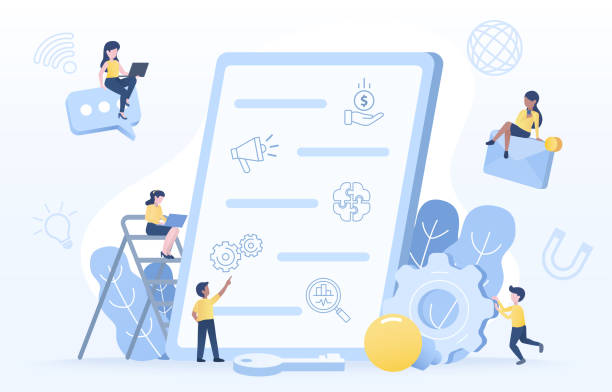
Entering global markets without an effective communication platform is almost impossible.
Multilingual website design is not just an option, but a necessity to gain a competitive advantage.
In a fiercely competitive world, the ability to communicate with potential customers in their native language can set you apart from your rivals.
This competitive advantage is not limited to more sales; it also includes increased brand awareness, deeper trust, and customer loyalty.
A multilingual website allows you to gain a deeper analysis of international user behavior and identify the specific needs of each region.
For example, you might discover what type of information users in Japan are more interested in and how they can benefit from your products.
This analytical data can then be used to optimize marketing strategies and content production for that specific market.
Furthermore, by providing #analytical and localized content, you can achieve higher rankings in local search engines of each country and attract more organic traffic.
This approach not only leads to exponential growth in your audience but also opens new doors for business opportunities and international collaborations for your business.
A multilingual website is a powerful tool for advancing and expanding business on a global scale.
3. Technical Considerations and Implementation Technologies for Multilingual Websites

Implementing a multilingual website design requires precise technical considerations and the selection of appropriate technologies.
There are various methods for providing multilingual content, each with its own advantages and challenges.
The most common methods include using subdomains, subdirectories, and country code top-level domains (ccTLDs).
The choice of each method depends on your SEO goals, website structure, and budget.
For example, subdirectories like `yoursite.com/fr/` are often preferred for global SEO, while ccTLDs like `yoursite.fr` are useful for stronger country targeting.
Content Management Systems (CMS) like WordPress, Joomla, or Drupal offer numerous plugins and tools to support multilingual functionality.
For instance, plugins like WPML for WordPress make managing translations and content synchronization much simpler.
Using a robust translation system, whether manual or machine (with human editing), is essential for maintaining content quality and accuracy.
Also, ensuring website compatibility with right-to-left (RTL) text display for languages like Persian or Arabic is an important technical aspect.
Below is a comparative table of different content translation approaches:
| Approach | Advantages | Disadvantages | Use Cases |
|---|---|---|---|
| Manual Translation | High accuracy, cultural localization, strong SEO | High cost, time-consuming, requires expert translators | Sensitive content, core markets, branding |
| Machine Translation (AI) | High speed, low cost, covers many languages | Lower accuracy, lack of localization understanding, requires editing | High-volume content, support pages, initial market testing |
| Hybrid Approach (Machine + Editing) | Balance of speed and quality, cost-effective | Requires translator for editing, more time-consuming than pure machine | Most commercial websites, blogs, explanatory content |
4. Challenges and Solutions for Content Translation and Localization

One of the biggest challenges in multilingual website design is moving beyond mere literal translation to achieve full localization.
Simply translating words cannot fully convey the original feeling and meaning of the content, especially when dealing with cultural differences, local idioms, and even humor.
For example, an appealing advertising slogan in one language might be meaningless or even offensive in another.
Therefore, #guidance and the use of native-speaking translators who are fully familiar with the target culture are crucial.
These translators can adapt the content to align with #engaging_content of local users and establish effective communication.
Using Translation Management Systems (TMS) can organize and simplify the localization process.
These systems allow you to centrally manage content, assign it to various translators, and track progress.
Also, paying attention to non-textual elements such as images, videos, and even colors, which can have different meanings in different cultures, is an important part of localization.
For example, the color red symbolizes love in some cultures and danger in others.
A multilingual website must consider these differences to avoid misunderstandings and provide a positive user experience.
Developing a glossary and a style guide for translators significantly helps maintain content consistency and quality across all languages.
Did you know that customers’ first impression of your company is your website? With a powerful corporate site from Rasaweb, multiply your business credibility!
✅ Exclusive and eye-catching design tailored to your brand
✅ Improved user experience and increased customer attraction
⚡ Get a free consultation!
5. Search Engine Optimization (SEO) for Multilingual Websites

Search Engine Optimization (SEO) in multilingual website design has its own complexities that go beyond traditional SEO.
To ensure that search engines like Google show the correct version of your content to users in the appropriate language and region, you must ensure the correct implementation of Hreflang tags.
These tags inform search engines that a specific page is a translated or localized equivalent of another page for a specific language or region.
Furthermore, conducting keyword research for each language separately is of high importance.
Keywords that are effective in one language may not be relevant in another or may have different search volumes.
Using #specialized SEO tools to analyze competitors in international markets and identify new opportunities for ranking is essential.
Also, creating separate XML sitemaps for each language and submitting them to Google Search Console helps search engines crawl multilingual content better.
It is important to have a unique URL for each language version and avoid using cookies to switch languages, as this confuses search engines.
#Analytical and localized content is not only appealing to users but is also valued by search engines, leading to improved rankings for your site in local and international searches.
A multilingual website with strong SEO is a bridge to international success.
6. User Experience (UX) and User Interface (UI) Design for Global Audiences
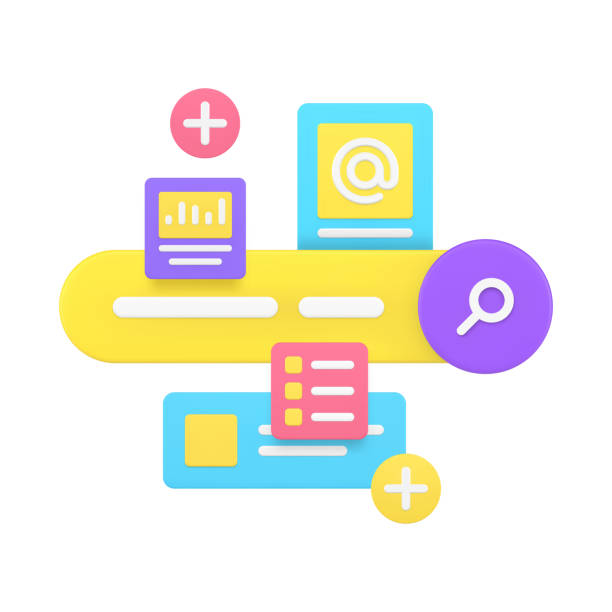
User Experience (UX) and User Interface (UI) design play a key role in the success of a multilingual website design.
The visual design and interaction with the website should be intuitive and pleasant for users from different cultures and languages.
This means that merely translating content is not enough; special attention must be paid to visual elements, layout, fonts, and even text direction (such as right-to-left for Persian and Arabic).
For example, selecting an appropriate font that supports all characters of the target languages and has high readability is crucial.
The language switching mechanism must be easily accessible and understandable.
Typically, a dropdown menu or country flags in the site header are used for this purpose.
However, it should be noted that using flags can be sensitive in some cases (e.g., for countries with multiple official languages or geographical regions without a specific political identity).
Providing a “Select Language” option with language names instead of flags is often better #guidance.
Also, ensuring that images and videos are localized and convey an appropriate message to local audiences is very important.
A multilingual website design should be such that no user, regardless of their language or culture, feels alienated and can easily interact with the site.
Providing #educational content on how to use the site in different languages can help improve UX.
7. Content Management and Updates on Multilingual Websites
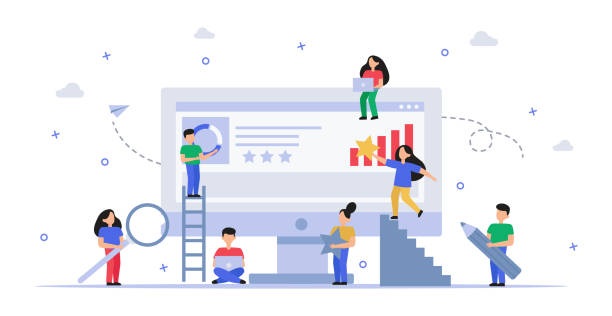
Managing and updating content on a multilingual website design can be challenging, especially when the number of languages is high and content changes frequently.
Careful planning and the use of appropriate tools are essential to maintain content consistency and synchronization across all language versions.
Advanced Content Management Systems (CMS) and multilingual plugins should offer capabilities for managing translation workflows, notifying about content changes, and simultaneous publishing in all languages.
It is recommended to prepare a comprehensive content calendar that includes the scheduling of content publication in all languages.
This calendar should apply to both new content and updates to existing content.
Also, to prevent future translation and localization issues, it is advisable to write original content in a way that is easy to translate and localize.
This means avoiding complex idioms, excessive local humor, and ambiguous phrases.
Finally, conducting periodic reviews by native speakers to ensure the quality and accuracy of translations is crucial.
This helps identify potential errors or linguistic inefficiencies that might be overlooked by automated tools.
Below is a checklist for efficient multilingual content management:
| Item | Description | Status |
|---|---|---|
| Multilingual CMS Platform | Use of a CMS with strong support for multiple languages. | Completed/In Progress |
| Content Calendar | Planning for content creation and publication across all languages. | Completed/In Progress |
| Translation Process | Defining a clear process for translation and localization. | Completed/In Progress |
| Native Speaker Review | Periodic review of content by native translators. | Completed/In Progress |
| Content Preparation for Translation | Writing original content in a translatable manner. | Completed/In Progress |
8. Security and Stability in Multilingual Website Design

Security and stability are two fundamental pillars for any website, but they become even more crucial in multilingual website design.
As the website’s reach expands to international audiences, the level of security threats also increases.
Cyberattacks can originate from various parts of the world, making the implementation of strong security protocols, including SSL/TLS, Web Application Firewalls (WAFs), and intrusion detection systems, essential.
It must also be ensured that any multilingual module or plugin added to the website has sufficient security and receives regular security updates.
Website stability also means its ability to provide continuous and uninterrupted service, even under high traffic or potential attacks.
Using scalable cloud infrastructures and Content Delivery Networks (CDNs) to distribute content on servers close to users worldwide can help improve site speed and stability.
This not only enhances user experience but is also very important for SEO.
For example, a slow-loading website can lead to an increased bounce rate and decreased search engine rankings.
Planning for regular backups of all language versions of the website and having a Disaster Recovery Plan are among the #analytical measures important for maintaining the stability and security of a multilingual website.
Overall, a proactive approach to security and stability prevents serious problems in the future.
Tired of losing customers due to poor e-commerce site design? With Rasaweb, solve this problem forever!
✅ Increase sales and visitor-to-customer conversion rates
✅ Smooth and engaging user experience for your customers⚡ Get a free consultation
9. Case Studies and Successes in Multilingual Website Implementation
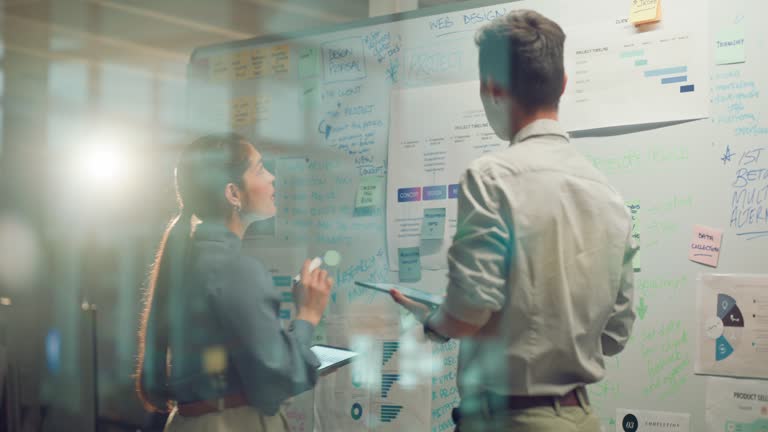
The remarkable successes of many large and small companies in global markets attest to the power of multilingual website design.
#case_study_related reviews of these websites can be inspiring and reveal best practices.
For example, large companies like Airbnb or IKEA are prominent examples of multilingual and localized websites that have successfully penetrated various markets worldwide.
They have not only translated their content but also adapted the user experience based on the cultural preferences of each region.
At a smaller scale, many #entertaining and specialized businesses have also achieved significant success by implementing multilingual websites.
For instance, an online handicraft store offering its unique products in several languages can attract customers from different parts of the world who would otherwise never have access to its products.
These success stories demonstrate how a multilingual website design can help increase sales, improve customer relations, and expand brand presence internationally.
They have carefully listened to the linguistic and cultural needs of their customers and provided content that speaks directly to them.
This not only boosts engagement but also strengthens brand trust and loyalty, enabling them to continue growing and innovating in new markets.
10. The Future of Multilingual Website Design and New Trends

The future of multilingual website design is intertwined with rapid advancements in Artificial Intelligence (AI) and Machine Learning (ML).
Machine translation tools are becoming increasingly accurate and efficient, helping businesses quickly scale their content into various languages.
However, even with these advancements, the need for human localization and editing by native speakers will remain crucial for maintaining content quality and cultural accuracy.
New trends in #engaging_content for multilingual websites include the use of multilingual Chatbots for customer support, localized interactive content, and even Virtual/Augmented Reality (VR/AR) to provide richer experiences to users in different languages.
Content personalization based on location, search history, and user language preferences is moving towards becoming smarter.
In the future, multilingual website design will increasingly move towards automating translation and localization processes, but the role of content strategists and localization specialists will become more prominent to ensure the accuracy and cultural relevance of content.
To succeed in this landscape, businesses must continuously learn and adapt to new technologies to provide the best experience for their global audience and, in doing so, maximize their share of the international market.
Frequently Asked Questions
| Question | Answer |
|---|---|
| What is multilingual website design? | It is a website design where content is available to users in several different languages, allowing users to choose their preferred language. |
| Why is a multilingual website important? | To reach international audiences, increase site traffic, improve user experience for non-Persian speaking visitors, and expand business in global markets. |
| What are the benefits of having a multilingual website? | Increased international SEO, attracting new customers from different countries, enhancing business credibility and professionalism, and reducing bounce rates by providing understandable content. |
| What are the methods for implementing a multilingual website? | Using subdirectories (e.g., example.com/en/), subdomains (e.g., en.example.com), or separate top-level domains for each language (e.g., example.com and example.de). |
| Which URL structure is best for international SEO? | Subdirectories (e.g., example.com/en/) are often preferred for SEO due to consolidating domain authority, although each method has its advantages and disadvantages. |
| How does a multilingual website affect SEO? | By providing content in different languages, the site appears in local search results for those languages, click-through rates and traffic increase, and overall domain authority improves. Correct use of hreflang tags is very important. |
| How is content translation managed? | You can use professional translators, machine translation tools (with human editing), or Content Management Systems (CMS) with built-in multilingual capabilities or relevant plugins. |
| What are common challenges in multilingual website design? | Managing translated content, maintaining design consistency across different languages, compatibility with right-to-left (RTL) languages like Persian and Arabic, optimizing SEO for each language, and choosing an appropriate URL structure. |
| How do I manage text direction (LTR/RTL) on a multilingual site? | For right-to-left languages (like Persian), you need to apply specific CSS styles to change text direction, element layout, and table direction. Often by using the `direction: rtl;` property and other related settings. |
| How can users change the site language? | Usually by using a button, dropdown menu, or language selector widget clearly placed in the site’s header or footer. Automatic detection of the user’s browser language and suggesting a language change is also common. |
And other services of Rasa Web Advertising Agency in the field of advertising
Smart Sales Automation: A professional solution for digital branding with a focus on intelligent data analysis.
Smart Custom Software: An effective tool for customer acquisition through SEO-driven content strategy.
Smart Marketplace: A combination of creativity and technology for user interaction by optimizing key pages.
Smart Social Media: A creative platform to improve click-through rates with precise audience targeting.
Smart Sales Automation: An effective tool for campaign management through optimizing key pages.
And over hundreds of other services in internet advertising, advertising consultation, and organizational solutions
Internet Advertising | Advertising Strategy | Advertorials
Sources
Digital Marketing Solutions for Iranian BusinessesAdvantages of Multilingual Website Design and Its PrinciplesDigital Transformation: From Concept to Implementation in BusinessesSteps to Enter Global Markets
? Is your business ready to leap into the digital world? Rasaweb Afarin Digital Marketing Agency, by providing comprehensive and innovative solutions, paves your path to success. From professional website design and SEO optimization to managing targeted advertising campaigns, we are with you at every stage of your business growth.
📍 Tehran, Mirdamad Street, next to Central Bank, Southern Kazeroun Alley, Ramin Alley, P.O. Box 6

